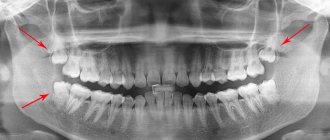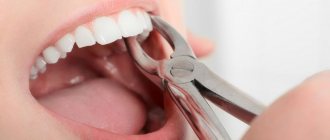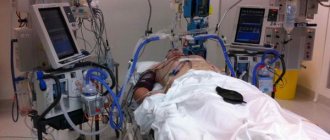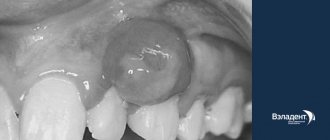From this article you will learn:
- Wisdom tooth removed - how long will it hurt?
- what are the complications?
- How long does it take for gums to heal after wisdom tooth removal?
The article was written by a dental surgeon with more than 19 years of experience.
According to statistics, after the removal of a wisdom tooth, inflammation of the socket of the extracted tooth occurs in 25-30% of cases. For example, after the removal of any other groups of teeth, inflammation occurs only in 3-5% of cases. This is due: firstly, to the higher complexity of removing wisdom teeth, and secondly, to the fact that they are surrounded by a large amount of soft tissue.
The last circumstance is very important, because the presence of moving soft tissues in the area of the extracted tooth socket often leads to the loss of the clot - its loss or even destruction. If the socket of the extracted tooth is not closed by a blood clot, inflammation will inevitably develop in it.
Gums after wisdom tooth removal (normal) –
When wisdom teeth are removed, stitches are almost always required. This is necessary because these teeth are located deep in the soft tissues and in this place the mucous membrane is very mobile. The absence of sutures in this situation can lead to prolapse of the clot and inflammation. But if the patient has a long jaw and there is enough space for the wisdom tooth, the socket will look traditional (Fig. 3).
To learn how the sockets of extracted teeth should normally heal, and how to speed up this process, read the article: “How long should gums take to heal?”
Why complications often occur after wisdom tooth removal -
It must be said that the severity of negative symptoms after wisdom tooth removal directly depends on the degree of traumatic removal. In turn, the incidence of trauma depends not only on the simple or complex position of the tooth in the jaw, but, first of all, on the qualifications of the dental surgeon.
For example, surgeons often spend 1-2 hours trying to remove a patient’s wisdom tooth with just forceps and an elevator - instead of immediately making an incision in the gum, drilling out some bone around the tooth and/or sawing the tooth crown into several parts (after that, removing each root by separately), and spending only 15-20 minutes on it.
Another main cause of complications after complex wisdom tooth removal is the use of a drill by the surgeon, the surgical tip of which is not water-cooled. As a result, a thermal burn of the bone occurs, followed by severe pain and the development of suppuration in the socket of the extracted tooth.
Important: thus, the main causes of inflammation and other complications are the mistakes and negligence of the dental surgeon during the removal process. However, a lot also depends on the doctor’s prescriptions. Correct prescriptions dramatically reduce the risk of developing inflammation of the socket.
How do dental surgeons remove wisdom teeth?
Typically, removing an upper wisdom tooth is easier than removing a lower wisdom tooth. This is due to the fact that the bone tissue of the upper jaw is softer and more porous, and therefore it is much more difficult to break off one of the roots (when removing a tooth from the socket). However, on the other hand, if the doctor does break off the top of one of the roots, then removing it from the upper jaw will be much more difficult. The latter is due both to the lack of good visual access and to the fact that working with thin elevators necessary to extract the root apex from the socket is much more dangerous in soft bone.
The bone tissue of the lower jaw is much denser, and lower wisdom teeth almost always have massive and/or often curved roots. Therefore, the roots of the lower wisdom teeth generally break off more often than the upper ones. But the doctor always has the opportunity to reduce the risk of such an outcome by taking an x-ray that will show us the shape and position of the roots in the jaw. If there is a risk of breaking off the root during tooth extraction, a good doctor will first saw it into pieces, after which he will separately remove the roots and parts of the crown. All this usually takes less than 15 minutes, but you come to understand this with experience.
But most often you can find a different picture, when the doctor uses all his might to loosen the tooth with forceps or tries to dislocate the tooth from the socket with an elevator, but one of the roots suddenly breaks off. Then the doctor begins to either pick at the wound for a long time with a thin elevator, or drill out the bone tissue (to get to the broken off tip of the root). In both cases, very significant trauma is caused to the jaw, which will lead to severe pain and inflammation of the wound in the postoperative period. Therefore, experience and understanding of the extraction strategy play a big role, and sometimes even a very complex tooth, on which one doctor can spend a whole hour, another may need only 5-10 minutes.
Simple and complex wisdom tooth removal –
Thus, removing the eighth tooth can be either simple or complex. In some cases, we can assume in advance that there will be a difficult removal. Here are a few options at a glance: 1) we need to remove a tooth that has not yet erupted above the mucous membrane, 2) on the x-ray we see curved roots, 3) the tooth has a strong slope towards the 7th tooth, resting against it with the crown in the cervical area, 4) the tooth has a horizontal position in the jaw, 5) the crown of the tooth is almost completely destroyed and there is no way to “catch” on it with instruments.
Variants of the position of the wisdom tooth in the jaw -
With similar options for the position of the wisdom tooth (as in the radiographs above), we plan a complex extraction in advance. But even removing such teeth with the right strategy may not be too difficult, taking only 15-20 minutes. Below we will describe in detail how simple wisdom tooth removal is carried out, and also show one of the options for complex removal.
What to do after wisdom tooth removal to avoid complications -
What to do after wisdom tooth removal will depend on the complexity of the removal. If the removal was simple (that is, it was not accompanied by an incision in the gum and cutting out the bone), then standard recommendations after removal will be sufficient. If the removal was difficult or was carried out against the background of purulent inflammation, then the following must be added to these recommendations...
- Antihistamines - these drugs are also called antiallergic. Taking them will reduce the swelling of the soft tissues of the cheek after removal, which will certainly appear the next morning, and in addition, they enhance the effect of analgesics. It is best to take Suprastin. This is a very strong drug, but with a hypnotic effect. Therefore, we recommend taking it in the first 2-3 days after removal shortly before bedtime (once a day).
– it is best to use analgesics from the NSAID group (non-steroidal anti-inflammatory drugs), which have both analgesic and anti-inflammatory effects. These include products based on ibuprofen, ketoprofen, etc.
NSAID-based analgesics
It is best to start taking these medications before your anesthesia wears off. Read about the right choice of medications at the link above. It is best to use them for the first 3 days, then as needed.
- Antibiotics – after a complex extraction, or if the removal was carried out against the background of inflammation in the tooth, taking antibiotics is mandatory. Because After tooth extraction, a bone wound is formed, then antibiotics should be specific to bone tissue. At the moment, the most popular antibiotics among dental surgeons are several drugs.
Firstly, Amoxiclav. The dosage for adults should contain 500 mg of amoxicillin and 125 mg of clavulanic acid. At this dosage, the drug is taken only 2 times a day. However, if you previously experienced diarrhea after taking antibiotics, then it is better to purchase another drug - Unidox-solutab in soluble tablets (taken 100 mg 2 times a day, 5 or 6 days).Very often, doctors also prescribe a drug from the Soviet past - Lincomycin capsules 0.25 (adult dosage - 2 capsules 3 times a day, for a total of 5-6 days). It is inexpensive, effective, but kills the entire intestinal microflora, causing you to suffer from dysbacteriosis later.
Clinical researches
Asept products are clinically proven effective. For example, clinical studies have proven that regular use of professional toothpaste ASEPTA REMINERALIZATION improved the condition of the enamel by 64% and reduced tooth sensitivity by 66% after just 4 weeks.
Clinical studies have proven that regular use of professional toothpaste ASEPTA COFFEE AND TOBACCO for a month improved the hydration of the mucous membrane by 3.3 times, the remineralizing efficiency increased by 3.9 times, at the same time, the cleansing effect has increasing dynamics and reaches 60 .5% at 4 weeks of use.
Sources:
- The role of anti-inflammatory rinse in the treatment of periodontal diseases (L.Yu. Orekhova, A.A. Leontyev, S.B. Ulitovsky) L.Yu. OREKHOVA, Doctor of Medical Sciences, Prof., Head of Department; A.A. LEONTIEV, dentist; S.B. ULITOVSKY, Doctor of Medical Sciences, Prof. Department of Therapeutic Dentistry of St. Petersburg State Medical University named after. acad. I. P. Pavlova
- Report on the determination/confirmation of the preventive properties of personal oral hygiene products “ASEPTA PLUS” Remineralization doctor-researcher A.A. Leontyev, head Department of Preventive Dentistry, Doctor of Medical Sciences, Professor S.B. Ulitovsky First St. Petersburg State Medical University named after. acad. I.P. Pavlova, Department of Preventive Dentistry
- Report on determining/confirming the preventive properties of toothpaste “ASEPTA PLUS” COFFEE and TOBACCO Author: doctor-researcher A.A. Leontyev, head Department of Preventive Dentistry, Doctor of Medical Sciences, Professor S.B. Ulitovsky. First St. Petersburg State Medical University named after. acad. I.P. Pavlova, Department of Preventive Dentistry
- The effectiveness of the use of Asept “adhesive balm” and Asept “gel with propolis” in the treatment of chronic generalized periodontitis and gingivitis in the acute stage (Municipal Dental Clinic No. 4, Bryansk, Kaminskaya T. M. Head of the therapeutic department Kaminskaya Tatyana Mikhailovna MUZ City Dental Clinic No. 4, Bryansk
What are the complications after wisdom tooth removal?
When a wisdom tooth has been removed, what to do after removal will directly depend on the symptoms that you experience. It must be said that according to statistics, complications after wisdom tooth removal occur in almost every 4th patient. Most often, patients encounter the following symptoms indicating the development of complications:
- severe spontaneous pain,
- pain when cold or hot water gets on the wound,
- swelling of the soft tissues of the cheek,
- unpleasant odor from the socket of an extracted tooth,
- painful swallowing
- difficulty opening the mouth,
- temperature,
- bleeding,
- the appearance of a hematoma on the face.
Pain after wisdom tooth removal –
Having a wisdom tooth pulled out, how long will it hurt is the most common question patients ask. How much your gums hurt after wisdom tooth removal directly depends on the degree of traumatic removal. Normally, pain after wisdom tooth removal should not be very strong and, once it occurs, it should gradually only decrease. After a simple removal, the pain usually goes away completely in 1-2 days, and after a complex one, normally in no more than 3-5 days.
If you have a wisdom tooth pulled out and the pain immediately after removal is very strong and practically does not decrease in the first days, this indicates that the removal is excessively traumatic and the possible development of inflammation of the socket of the extracted tooth (alveolitis). Here you need to urgently go to the dentist for a second examination. In the worst case scenario, pain can last up to 3-4 weeks.
Symptoms of inflammation of the wisdom tooth socket - upon examination, you can see that the socket is empty, or it is filled with food debris and necrotic decay of a blood clot. Sometimes patients feel sharp/moving bone fragments with their tongue. There is always pain, there is always an unpleasant smell from the hole. The mucous membrane is swollen and red. Such symptoms are characteristic of a mild form.
However, in some cases, inflammation of the socket occurs with abundant formation of pus, swelling of the cheek, difficulty opening the mouth and painful swallowing. And it must also be said that if you experience pain when responding to cold or hot water, this clearly indicates the presence of an exposed area of bone. In any case, only a dentist can help you.
Inflammation of the socket of an extracted wisdom tooth: video
Below you can see what inflammation of the sockets of removed wisdom teeth looks like in the video. Please note that in video 2, when you press on the gums in the area of both removed wisdom teeth, thick pus comes out of the patient’s sockets.
Reasons for the development of alveolitis - if the patient rinses his mouth vigorously in the first days after extraction, this can lead to a blood clot falling out of the socket of the extracted tooth. This leads to inflammation in 100% of cases, because... the hole is immediately filled with food debris and microbes from the oral cavity. But in most cases, alveolitis still develops due to the fault of the doctor -
- traumatic removal,
- fragments or slightly movable bone fragments are left in the socket,
- when cutting out the bone, the doctor used a drill tip without water cooling, which led to overheating and necrosis of the bone,
- the doctor was too lazy to suture the mucous membrane above the hole (in some cases this can lead to exposure of a section of bone in the next few days),
- The doctor did not prescribe antibiotics after a complex extraction, or in the case when the tooth was removed due to inflammation.
Important: alveolitis is the most common complication after wisdom tooth removal. If the described symptoms occur, you should immediately run to the doctor and treat alveolitis. From experience I can say that when a doctor sutures a hole even after a simple removal, the number of cases of alveolitis development is almost zero. In addition, studies have shown that suturing the socket reduces the severity of pain after removal by 30-50%. Therefore, before removal, you should definitely ask the doctor to suture your hole, even if you have to pay extra for it (about 500 rubles for 2 stitches).
Causes of retention
As you know, wisdom teeth are largely a vestigial organ and have lost their importance in the process of evolution. About 10% of the world's population does not have the rudiments of wisdom teeth at all, while in others they erupt without complications and harmoniously take their place in the dentition. There is a third option, when a person has the beginnings of wisdom teeth, but various difficulties arise during eruption. Retention is one of these complications. Among the most common causes of such teeth, experts identify:
- hereditary factor;
- early loss of baby teeth (removal of an impacted wisdom tooth in a teenager is often associated with this factor);
- too dense or thick gingival walls;
- crowded dentition and malocclusion.
Swelling after wisdom tooth removal –
If you have a wisdom tooth removed and your cheek is swollen the next day, then in some cases this is normal.
Normally, after simple removal, swelling rarely develops, and most often it occurs in people with an abundance of subcutaneous fat on the face. Such swelling most often becomes noticeable only in the morning of the next day. Normally, after a complex removal, swelling gradually develops immediately and gradually increases, becoming maximum the next morning. Usually the swelling is stable over the next 1-2 days, after which it begins to slowly decrease. If, against the background of swelling, there is no increasing temperature or pain, but on the contrary, all symptoms slowly decrease, then everything is OK.
- When removing an upper wisdom tooth, swelling of the upper cheek may occur (even if the removal was simple). The appearance of edema in this case is due to the fact that the area where the upper wisdom teeth are located is very richly supplied with blood, and therefore swelling of the surrounding soft tissues occurs. If the removal of the upper wisdom tooth was difficult or was carried out against the background of inflammation, then the occurrence of edema is all the more not surprising.
- When removing lower wisdom teeth -
swelling is natural if the removal was complicated (an incision was made, a bone was drilled, a tooth was sawed), or the tooth was removed due to inflammation. Swelling of the surrounding soft tissue near the removed lower wisdom tooth can lead to painful swallowing or difficulty opening the mouth.
When to sound the alarm - if swelling continues to increase over the next 1-2 days after removal, pain and temperature may also increase, pain when swallowing increases, and the mouth opens less and less - all these are unfavorable symptoms indicating suppuration. If you have at least one of the symptoms listed, you need to urgently run to the dentist.
Important: to ensure that swelling does not appear after wisdom tooth removal or is minimal, it is advisable to take antihistamines (Suprastin is best) for the first 2-3 days before going to bed - once a day before bed. Antihistamines have not only an antiallergic effect, but also a decongestant.
Indications for removal
If the extreme molars are formed correctly, then they are no different from other teeth. They can be affected by caries, which turns into pulpitis, periodontitis and other diseases. The dentist decides whether to remove a wisdom tooth after a detailed examination of the x-ray. It shows the location, quantity, structure of roots, carious cavities, condition of the canals, direction of growth, neoplasms and other pathologies.
The tooth is removed if there is:
- advanced form of caries with complications: pulpitis, cysts, complex, tangled canals that cannot be properly cleaned and sealed;
- neurological pain, constant inflammation of tissues during teething, partially erupted teeth (pericoronitis);
- strong pressure on neighboring molars, pathological changes in bite;
- incorrect position of the teeth, which leads to injury to the mucous membranes.
Carious lesions and inflammation on figure eights occur quite often due to the difficulty of access for hygiene procedures. If caries is not cured in a timely manner, it will spread to neighboring teeth, since they are located very close to each other.
During the growth of the last molars, branches of the trigeminal nerve tissue may become inflamed. In this case, not only the jaw hurts, but also the head. If the problem cannot be eliminated by therapy, then removal is performed.
When there is little space on the jaw, an overgrown wisdom tooth can put a lot of pressure on neighboring dental units, causing constant pain and changing the correct bite. For the same reason, they can grow crookedly, cut into the gums from the side and injure the mucous membranes of the cheeks.
The third molar takes a long time and painfully to erupt. Bacteria penetrate into the slightly open gum tubercle, food particles enter, causing an inflammatory process. The soft tissues become inflamed, causing pain that radiates to the ear and temple. Under the “hood” a favorable environment is created for the development of bacteria, so inflammation develops quickly and purulent contents appear. This position can lead to melting of bone tissue and other complications, so the dental unit is removed and anti-inflammatory therapy is carried out.
Often a cyst forms on wisdom teeth. The disease is asymptomatic and is detected only during instrumental examination of the jaw. If it is not removed, it can subsequently become a source of severe inflammation, osteomyelitis.
Temperature after wisdom tooth removal –
- If the tooth was removed NOT due to inflammation - if your wisdom tooth was removed, the temperature may well rise to 37.5 degrees, but only on the first evening.
The body sometimes reacts to injury with just such a low-grade fever, even if the tooth was not removed due to inflammation. This is especially true if the removal was difficult. Normally, the next morning after removal, the temperature should disappear (24stoma.ru). When to sound the alarm: if the temperature does not subside the entire next day after extraction, and even more so continues to increase, then this indicates suppuration of the hole of the extracted tooth. All you need to do is run to the dentist.
- If the tooth was removed due to purulent inflammation, in this case the temperature may be higher than 37.5. But normally, from the next day the temperature should decrease progressively. If it persists and, even more so, increases (this indicates an increase in inflammation), you need to urgently go to the dentist.
Bleeding after wisdom tooth removal –
Usually, in the socket of an extracted tooth, blood clots instantly, but with increased pressure or injury to a large vessel, prolonged bleeding may occur. Bleeding after wisdom tooth removal is not a big deal if it occurs while still in the dentist’s chair. The doctor will then immediately suture the wound with suture material and/or place a hemostatic hemostatic sponge into the socket of the extracted tooth (Fig. 8).
However, very often bleeding after tooth extraction occurs after leaving the clinic. Experienced doctors, to be on the safe side (especially if a large tooth is removed and the patient has a history of hypertension), usually always put 1-2 sutures on the wound, just to prevent bleeding. In addition, suturing allows the wound to heal faster.
Bleeding after removal of the upper 8th tooth: video
More detailed information on the possibilities of stopping bleeding at home is in the article: → “How to quickly stop bleeding after tooth extraction”
Hematoma after wisdom tooth removal –
A hematoma appears due to the fact that a vessel in the soft tissues has been injured. There is no point in blaming the doctor for this, because... When administering anesthesia, the doctor does not see where the vessels pass in your soft tissues. The needle can injure such a vessel and after a few days the skin may appear blue. Gradually it will pass.
However, the formation of a hematoma may require additional measures. A hematoma often festeres after the removal of a wisdom tooth. In this case, already on this day or the next day after removal, the patient experiences swelling of the cheek, a feeling of fullness, pain, and a slight fever. Here you need to urgently consult a doctor, because... when the hematoma suppurates, an incision is required to release the pus.
Types of Impacted Teeth
The term “impacted” can be applied not only to “eights”, but also to other teeth that are hidden in soft tissue. Depending on the degree of immersion of the tooth in soft tissues, complete or partial retention is distinguished. In addition, the depth of the tooth is also important. If it is located in bone tissue, then it is an impacted tooth with bone immersion. There is also the concept of an impacted dystopic tooth, that is, one that is located out of place or grows at the wrong angle (the so-called displacement of the dental axis). There may be several options here:
- medial impacted tooth (tooth tilted forward);
- distal impacted tooth (tooth deviates backwards);
- horizontal impacted tooth (the impacted tooth is located horizontally relative to the dentition);
- reverse impacted tooth (the tooth is upside down - the root part is located at the top and the coronal part is at the bottom).
We answer frequently asked questions from patients -
If you have a wisdom tooth removed: what to do after removal, what to rinse with, how quickly the hole will heal and when it will be possible to treat your teeth... We answer all questions separately.
How to rinse your mouth after wisdom tooth removal -
It is best to rinse your mouth after wisdom tooth removal with the antiseptic Chlorhexidine. This drug is sold in every pharmacy and costs only about 30 rubles per 100 ml bottle. Please note that you can only rinse your mouth slowly, because... Strong rinsing can cause a blood clot to fall out of the socket of the extracted tooth. The latter will lead to the development of inflammation.
How long does it take for gums to heal after wisdom tooth removal?
How long it takes for the gums to heal after wisdom tooth removal depends on the complexity of the removal. Typically, you must wait 1 week to begin treatment after wisdom tooth removal. But after a complex removal, the gums may take longer to heal (up to 10-14 days), which will depend on the degree of traumatic removal. If inflammation occurs in the hole, healing may take 20-30 days. We hope that our article on the topic: Wisdom tooth removal, how much it hurts, turned out to be useful to you!
Sources:
1. Dental education of the author of the article, 2. Based on personal experience as a dental surgeon, 3. National Library of Medicine (USA), 4. “Pathology of wisdom teeth eruption” (Rudenko A.), 5. “Qualified removal of third molars” (Asanami S.).










